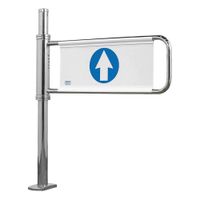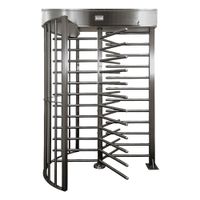Call +(254) 703 030 000 / 751 483 999 / 721 704 777
- Home
- Security
- Access Barriers Crowd Control
- Turnstiles Swing Gates
.....Read More
Frequently Asked Questions
What are the benefits of using turnstiles for crowd control?
Turnstiles offer several benefits for crowd control, enhancing both security and efficiency in managing large groups of people.
1. **Access Control**: Turnstiles regulate entry and exit, allowing only one person to pass at a time. This helps prevent unauthorized access and ensures that only individuals with proper credentials can enter restricted areas.
2. **Flow Management**: By controlling the rate at which people enter or exit, turnstiles help maintain a steady flow, reducing congestion and bottlenecks. This is particularly useful in high-traffic areas like stadiums, subways, and amusement parks.
3. **Security Enhancement**: Turnstiles can be integrated with security systems such as ID card readers, biometric scanners, or ticketing systems, providing an additional layer of security. This integration helps in monitoring and recording entries and exits, which is crucial for security audits and investigations.
4. **Data Collection**: Turnstiles equipped with electronic systems can collect data on the number of people passing through, peak usage times, and other metrics. This information is valuable for planning and optimizing operations, staffing, and resource allocation.
5. **Cost Efficiency**: By automating entry and exit processes, turnstiles reduce the need for manual monitoring by security personnel, leading to cost savings in staffing.
6. **Safety**: In emergency situations, turnstiles can be programmed to allow free passage, facilitating quick evacuation. Some models are designed to collapse or unlock automatically in case of power failure or fire alarms.
7. **Durability and Reliability**: Turnstiles are built to withstand heavy use and harsh environmental conditions, making them a reliable choice for both indoor and outdoor applications.
Overall, turnstiles provide a practical solution for managing large crowds, enhancing security, and improving operational efficiency.
How do turnstiles ensure one person at a time entry and exit?
Turnstiles ensure one person at a time entry and exit through a combination of mechanical design and electronic control systems. The primary mechanism is the rotating barrier, typically consisting of three or four arms that rotate around a central axis. This design physically restricts passage to one person per rotation.
When a person approaches the turnstile, they must present a valid ticket, card, or token to unlock the mechanism. Once validated, the turnstile allows a single rotation, permitting one person to pass. The arms then return to their original position, ready for the next user. This mechanical action prevents tailgating, where multiple people attempt to pass through on a single validation.
Advanced turnstiles incorporate sensors and electronic systems to enhance security and efficiency. Optical sensors detect the presence and movement of individuals, ensuring that only one person passes per validation. If the sensors detect more than one person attempting to pass, the system can trigger an alarm or lock the turnstile to prevent unauthorized entry.
Some turnstiles use full-height barriers, which extend from the floor to above head height, further preventing unauthorized access by making it difficult to climb over or under. These are often used in high-security areas.
In addition to physical and electronic measures, turnstiles can be integrated with access control systems, allowing for real-time monitoring and data collection. This integration helps in managing crowd flow, ensuring security, and maintaining accurate records of entries and exits.
Overall, the combination of mechanical barriers, electronic validation, and sensor technology ensures that turnstiles effectively control the flow of people, allowing only one person to enter or exit at a time.
What are the differences between turnstiles and swing gates?
Turnstiles and swing gates are both access control devices used to manage the flow of people into and out of a facility, but they differ in design, functionality, and application.
**Design and Structure:**
Turnstiles are typically waist-high or full-height barriers with rotating arms that allow one person to pass at a time. They are often made of metal and are designed to be robust and tamper-resistant. Swing gates, on the other hand, consist of a single or double gate that swings open to allow passage. They can be made from various materials, including metal, glass, or plastic, and are often more aesthetically pleasing.
**Functionality:**
Turnstiles are designed to control and count the number of people entering or exiting a space. They often require a ticket, card, or biometric verification to unlock and rotate, ensuring that only authorized individuals gain access. Swing gates can also be integrated with access control systems but are generally more versatile, allowing for the passage of larger items, such as strollers or wheelchairs, making them more accessible.
**Application:**
Turnstiles are commonly used in high-security environments like stadiums, amusement parks, and public transport stations, where controlling and monitoring the flow of large crowds is essential. Swing gates are more suited for environments where accessibility is a priority, such as office buildings, airports, and retail stores, where a more welcoming and less restrictive entry is desired.
**Security and Control:**
Turnstiles offer higher security due to their ability to restrict entry to one person at a time, reducing the risk of tailgating. Swing gates, while providing some level of access control, are generally less secure as they can be held open, allowing multiple people to pass through simultaneously.
In summary, the choice between turnstiles and swing gates depends on the specific needs of the facility, balancing security, accessibility, and user experience.
Are turnstiles suitable for wheelchair access?
Turnstiles are generally not suitable for wheelchair access. Traditional turnstiles are designed to control pedestrian flow and prevent unauthorized entry, but their design inherently restricts access for individuals using wheelchairs. The rotating arms of a standard turnstile create a physical barrier that is difficult, if not impossible, for a wheelchair to navigate.
For facilities that require both security and accessibility, alternative solutions are necessary. Accessible gates or doors, often located adjacent to turnstiles, are typically used to accommodate wheelchair users. These gates are wider and can be operated manually or automatically, allowing for easy passage. They are designed to comply with accessibility standards, such as the Americans with Disabilities Act (ADA) in the United States, which mandates that public spaces be accessible to individuals with disabilities.
In addition to accommodating wheelchairs, these accessible gates can also serve other purposes, such as allowing entry for individuals with strollers, bicycles, or large luggage. They can be integrated with the same access control systems used for turnstiles, ensuring that security is maintained while providing necessary accessibility.
In summary, while traditional turnstiles are not suitable for wheelchair access, facilities can implement accessible gates or doors to ensure compliance with accessibility standards and provide an inclusive environment for all individuals.
How do swing gates accommodate strollers and wheelchairs?
Swing gates accommodate strollers and wheelchairs by incorporating several design features that ensure accessibility and ease of use. Firstly, they are typically wider than standard gates, providing ample space for strollers and wheelchairs to pass through without difficulty. This extra width is crucial for maneuvering and ensures that users do not have to struggle with tight spaces.
Secondly, swing gates often have a smooth, level threshold or no threshold at all, which eliminates any potential tripping hazards or obstacles that could impede the movement of wheels. This design consideration is essential for maintaining a seamless transition from one side of the gate to the other.
Additionally, swing gates are equipped with user-friendly latching mechanisms that can be easily operated with one hand. This feature is particularly beneficial for caregivers or individuals who may need to hold onto a stroller or wheelchair while opening the gate. The latches are often positioned at a height that is accessible to both standing and seated users, ensuring that everyone can operate the gate independently.
Moreover, many swing gates are designed to open in both directions, providing flexibility and convenience in various settings. This bidirectional opening capability allows users to choose the most suitable direction for entry or exit, depending on their specific needs and the surrounding environment.
Finally, swing gates are often constructed from durable materials that can withstand frequent use and exposure to the elements, ensuring long-term reliability and safety. These materials are typically smooth and free of sharp edges, reducing the risk of injury to users.
Overall, the thoughtful design of swing gates ensures that they are accessible, safe, and convenient for individuals using strollers and wheelchairs, promoting inclusivity and ease of movement in public and private spaces.
What are the maintenance requirements for turnstiles?
Turnstile maintenance is crucial for ensuring their longevity and reliable operation. Key maintenance requirements include:
1. **Regular Inspection**: Conduct routine checks to identify wear and tear, misalignment, or damage. Inspect mechanical components, electronic systems, and structural integrity.
2. **Lubrication**: Apply appropriate lubricants to moving parts such as hinges, pivots, and locking mechanisms to ensure smooth operation and prevent rust.
3. **Cleaning**: Regularly clean the turnstile to remove dust, dirt, and debris. Use non-abrasive cleaners to avoid damaging surfaces, especially on stainless steel or glass components.
4. **Electrical System Check**: Inspect wiring, connections, and power supplies. Ensure that all electronic components, such as sensors and control boards, are functioning correctly.
5. **Software Updates**: Keep the turnstile’s software and firmware up to date to enhance security features and improve performance.
6. **Calibration**: Periodically calibrate sensors and control systems to maintain accuracy in detecting and processing entries.
7. **Safety Features**: Test safety mechanisms, such as emergency release functions and anti-panic features, to ensure they operate correctly in case of emergencies.
8. **Component Replacement**: Replace worn-out or damaged parts promptly to prevent further damage and maintain operational efficiency.
9. **Alignment and Adjustment**: Check and adjust the alignment of arms and barriers to ensure they are correctly positioned and operate smoothly.
10. **Record Keeping**: Maintain detailed records of all maintenance activities, inspections, and repairs to track the turnstile’s condition and plan future maintenance.
11. **Professional Servicing**: Engage professional technicians for complex repairs or when specialized knowledge is required, ensuring compliance with manufacturer guidelines.
Regular maintenance not only extends the lifespan of turnstiles but also ensures security and efficiency in controlling access.
How do turnstiles integrate with security systems?
Turnstiles integrate with security systems by serving as physical barriers that control and monitor access to restricted areas. They are equipped with electronic components that communicate with access control systems, ensuring that only authorized individuals can enter. Here's how they integrate:
1. **Access Control Integration**: Turnstiles are connected to access control systems, such as card readers, biometric scanners, or mobile access apps. When a user presents their credentials, the system verifies them against a database. If authorized, the turnstile unlocks, allowing passage.
2. **Real-Time Monitoring**: Turnstiles are often linked to security management software that provides real-time monitoring and logging of entry and exit activities. This data can be used for auditing and ensuring compliance with security protocols.
3. **Alarm Systems**: Turnstiles can be integrated with alarm systems to alert security personnel of unauthorized access attempts or tailgating incidents. If someone tries to bypass the turnstile without proper authorization, an alarm can be triggered.
4. **Integration with Surveillance**: Turnstiles can be synchronized with CCTV cameras to capture video footage of individuals passing through. This integration helps in verifying identities and investigating security incidents.
5. **Visitor Management**: For areas with visitor access, turnstiles can be integrated with visitor management systems. Visitors receive temporary credentials, which are validated at the turnstile, ensuring they only access permitted areas.
6. **Emergency Protocols**: In case of emergencies, turnstiles can be programmed to unlock automatically, allowing for quick evacuation. They can also be integrated with fire alarm systems to ensure compliance with safety regulations.
7. **Data Analytics**: The data collected from turnstile usage can be analyzed to optimize security staffing, identify peak access times, and improve overall security strategies.
By integrating with these systems, turnstiles enhance security by providing controlled access, monitoring, and data collection, contributing to a comprehensive security infrastructure.

